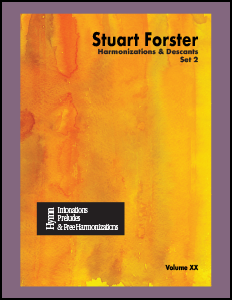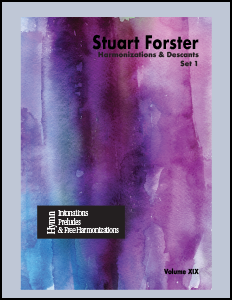|
Composer Stuart Forster
Released 7/18
Use hymn accompanying
Difficulty Moderately easy
Catalog no. 160-739 (Set 1);
160-740 (Set 2)
Price $20/each (U.S.)
Order set 1 (160-739)
Advent/Christmas/Epiphany/General


Order set 2 (160-740)
Lent/Easter/Pentecost/General


Description
Stuart Forster is a seasoned church musician with particular interest in exploring the art of congregational singing and creative accompanying, and he has authored a book on the subject. These generous collections of harmonizations and descants provides a rich source of material for use in worship. While a number of familiar tunes are present, also included are hymns that do not have as much published material available. The descants are provided in tune-only reproducible form at the end of the collection for use by the choir. |
 |
Review
"For many years, Selah Publishing Co. has been dedicated to publishing the best of contemporary church music. They have recently released volumes XIX and XX in their series 'Hymn Intonations, Preludes & Free Harmonizations by various authors. ... Volumes XIX and XX consist of 'Harmonizations & Descants' by AAM member Stuart Forster. Dr. Forster has given much consideration to hymn accompaniments and the role of the organist and choir in worship. His doctoral dissertation focused on current practices of hymn leadership and accompaniment with the organ. … His preface offers some ruminations on the role of the organist and the choir in leading the congregation in a way that enhances the meaning of the text and energizes the congregation. He writes:
‘In the fine details of crafting an accompaniment, harmony, articulation, and the simultaneous movement of multiple voice (“voice leading” in organists’ jargon) each play a role--sometimes subtle, often dynamic--in creating forward momentum, binding a congregation together while energizing the overall shape of a hymn, especially in the critical final stanza that lingers in the air after the last chord dies away.’
Each hymn in these two volumes is provided with a choral descant for the final stanza and occasionally an accompaniment or descant for another stanza as well. Most of the time, the top line of the organ part doubles the descant. This enables the organ part to be used alone as a free accompaniment, if desired, although this is not mentioned (or sanctioned!) by the composer. There may be some situations where it is preferable to modify the organ part to bring out the melody, whether on a solo reed or by making it the top line Every organist has a unique relationship with his or her congregation; in a healthy and trusting one, the organist knows just how much she or he can push the congregation without losing them. I enjoy the arrangements in this volume, but they assume and require familiarity with the hymn as well as a strong choir to lead the singing.
The tunes are taken from The Hymnal 1982, with the beautiful additions ANGEL VOICES and BESANÇON CAROL (People, Look East). Besides hymns of a general nature, Set 1 provides settings for the seasons of Advent, Christmas, and Epiphany, while Set 2 offers settings for Lent, Easter, Ascension, and Pentecost, as well as general hymns. It is lovely to see the inclusion of some hymns that are not often treated, such as FINNIAN, GOPSAL, LITTON, and RENDEZ Á DIEU as well as a few gentle hymns, such as SLANE and ST. COLUMBA. Among the most effective settings are ENGELBERG (2 stanzas), HANOVER, HYFRYDOL, KINGSFOLD, LASST UNS ERFREUEN, LLANFAIR, RICHMOND, SINE NOMINE (2 stanzas), and SLANE.
The descants are printed separately (vocal part only) in the second half of the book and may be photocopied for the choir. In addition, there is an index by tune name for the entire twenty-volume series at the end of volume XX. To use a vinous analogy that I believe the author would appreciate, one might compare these harmonizations to a fine claret, as opposed to a ‘fruit bomb’ from California. There is richness, but it is detailed and focused, with some restraint and elegance. This distinguishes it from the over-reliance on certain dramatic chords and harmonic progressions in many reharmonization books. The real richness come from elegant part writing and the knowledge, born of experience, that the greatest impact can sometimes be made when you do not overuse the tools in your toolkit.
...Volume XX [is] the volume I would recommend if you are looking to buy just one.” --AAM Journal, December 2018
|

"There is richness, but it is detailed and focused, with some restraint and elegance. This distinguishes it from the over-reliance on certain dramatic chords and harmonic progressions in many reharmonization books. The real richness come from elegant part writing and the knowledge, born of experience, that the greatest impact can sometimes be made when you do not overuse the tools in your toolkit."
--AAM Journal
Set 1 tunes included:
Abbot’s Leigh, Besançon Carol, Birmingham, Darwall’s 148th, Dulce Carmen, Gopsal, Hanover, Hereford, King’s Lynn, Laudate Dominum, Litton, Lobe den Herren, Nun Danket alle Gott, Ora Labora, Regent Square, Rendez à Dieu, Rustington, St. Anne, St. Denio, Slane, Winchester New, Winchester Old, Woodlands

Set 2 tunes included:
Angel Voices, Aus der Tiefe/Heinlein, Crimond, Down Ampney, Engelberg, Finnian, Gardiner, Hyfrydol, In Babilone, Kingsfold, Lasst uns Erfreuen, Llanfair, Nicaea, Puer Nobis, Richmond, St. Botolph, St. Columba, St. Magnus, Salzburg, Sine Nomine, Straf mich nicht, Victory

|



